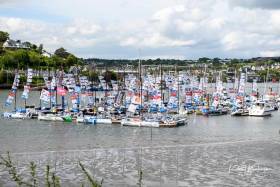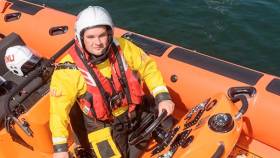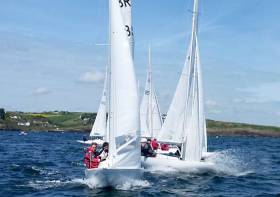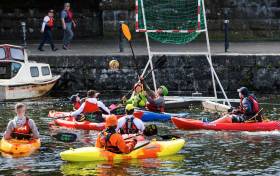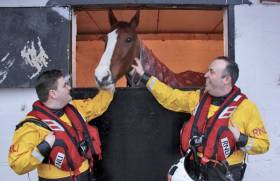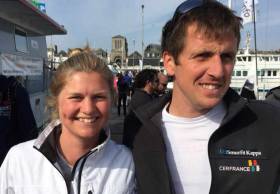Displaying items by tag: Kinsale
Recovering from the baptism of fire that was leg one of the 50th La Solitaire URGO Le Figaro race into Kinsale on Thursday, both Irish entrants, Tom Dolan and Joan Mulloy, attended the Skipper's briefing in Kinsale this afternoon as the south coast town greeted the international fleet.
From what is considered the most competitive fleet ever, Yoann Richomme won the opening stage of the 50th La Solitaire URGO Le Figaro. The open, strategic 545-nautical mile leg from Nantes across the Celtic Sea to Kinsale in Ireland proved to be an appropriately testing introduction of the new Figaro Beneteau foil assisted one design yacht.
 Tom Dolan (left) with Joan Mulloy and her sponsor Enda O'Coineen of the Sunday Business Post
Tom Dolan (left) with Joan Mulloy and her sponsor Enda O'Coineen of the Sunday Business Post
Predominantly light and very changeable winds prevailed through the marathon four days and four nights of racing offering very little opportunity to rest. Expected to finish into the picturesque Irish haven on Wednesday, the stage overran by a full 24 hours.
 The Skippers Briefing at Kinsale's White Lady night club
The Skippers Briefing at Kinsale's White Lady night club
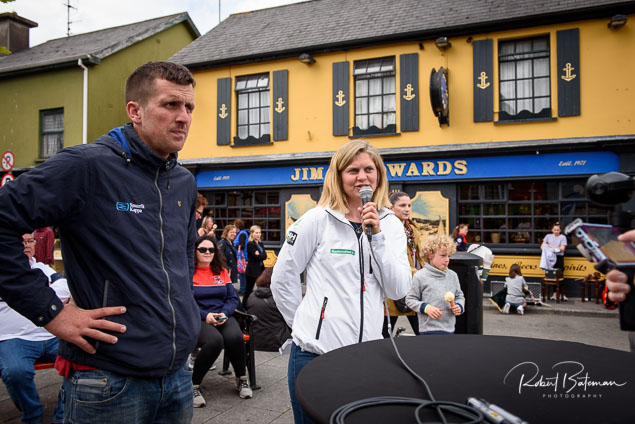 Tom and Joan give their impressions of the first leg at a public reception in Market Square
Tom and Joan give their impressions of the first leg at a public reception in Market Square
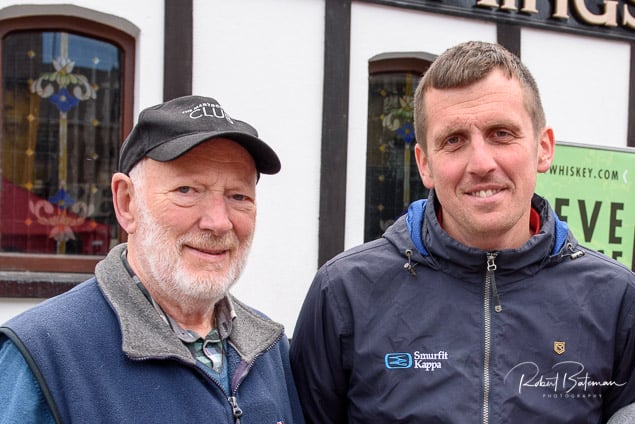 Jim Lyons of RCYC at the Figaro public reception in Kinsale's Market Square
Jim Lyons of RCYC at the Figaro public reception in Kinsale's Market Square
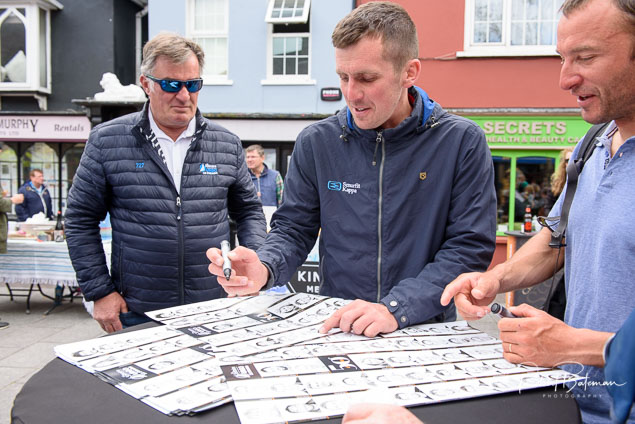
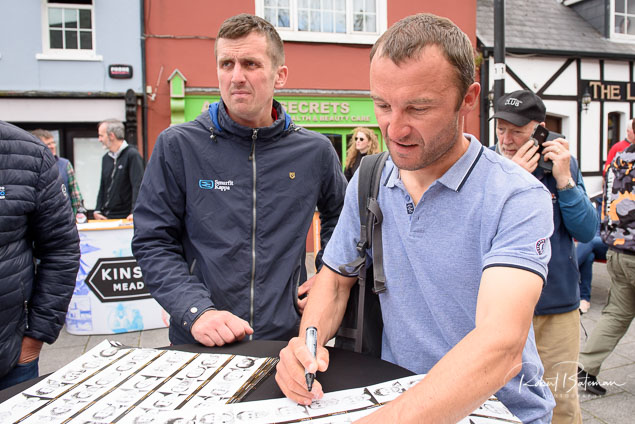 Competitor Adrien Hardy, who is from Nantes is a former French 420 dinghy champion and Mini class racer
Competitor Adrien Hardy, who is from Nantes is a former French 420 dinghy champion and Mini class racer
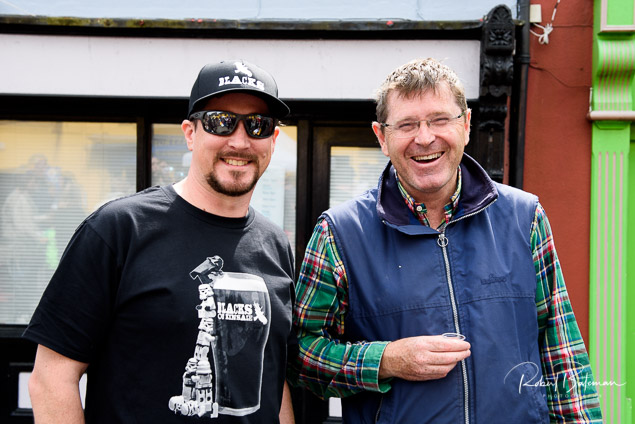 Kinsale Yacht Club Vice Commodore Mike Walsh (right)
Kinsale Yacht Club Vice Commodore Mike Walsh (right)

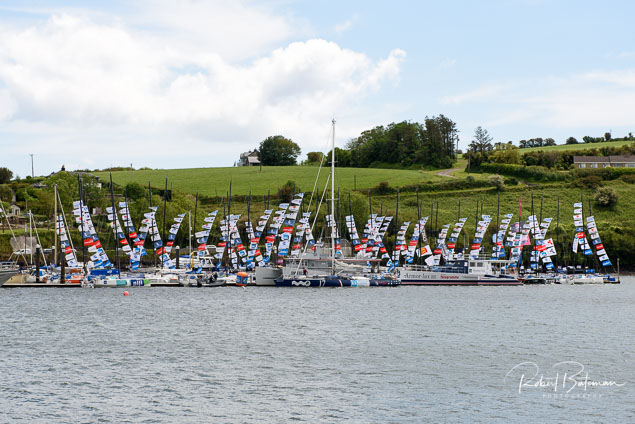
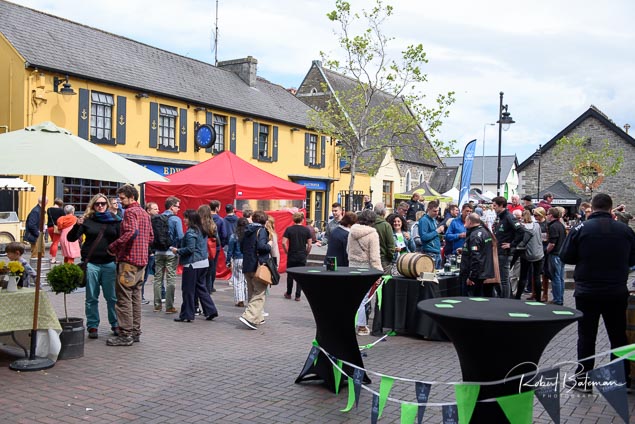
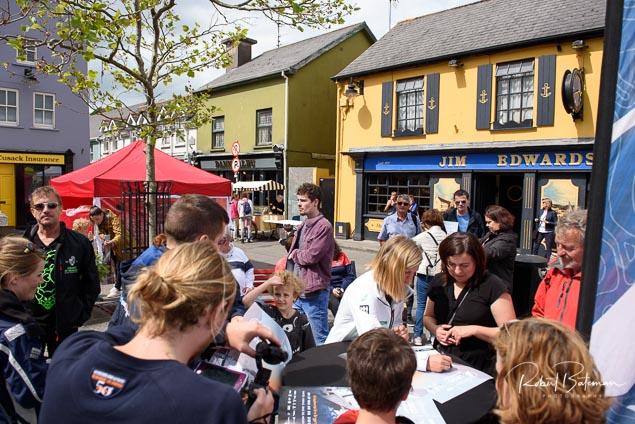
Exactly one week after he was passed out as a helm on Kinsale’s Atlantic 85 lifeboat, Miss Sally Anne Baggy II, 21-year-old Jonathan Connor rescued a swimmer from the sea close to Sandycove Island in Co Cork.
Miss Sally Anne Baggy II was tasked by Valentia Coast Guard just after 8am yesterday (Wednesday 15 May) when three swimmers reported that the fourth member of their party was missing.
Jonathan — who, along with fellow volunteer Lenny Fourie, was passed out as an RNLI helm last Wednesday 8 May — knew time was of the essence as the swimmer had been in the water for a considerable length of time.
Using his RNLI training and local knowledge, Jonathan quickly located the swimmer and in under 15 minutes had brought him to safety.
The swimmer, who displayed signs of exhaustion and hypothermia, was treated by paramedics at the lifeboat station and was able to return home.
Jonathan, a student at CIT, is one of the youngest helms in the RNLI fleet but is already an experienced sailor and a qualified commercial diver.
Kinsale RNLI lifeboat operations manager Kevin Gould said: “Time was of the essence today and thankfully the swimmer is safe and well and we wish them a speedy recovery. It was a baptism of fire for Jonathan but he ran a textbook operation.
“As always in the RNLI, it was down to teamwork, but Jonathan showed great leadership. He worked very hard to earn his place as a helm, and his training has paid off. We are all very proud of him.”
Respect the Water is the RNLI’s national drowning prevention campaign. If you see anyone in trouble at the coast or get into difficulties yourself, dial 999 or 112 and ask for the coastguard.
Calendars in Kinsale fill quickly and Sunday saw the annual Ecumenical service of Sea Sunday attract sailors and fishermen and first responders to the seaside town. The annual vintage car rally added character and colour and one mile South of Sandycove Island the second day of the Barry Ryan Civil Engineering sponsored open keelboat Regatta saw Dragons and Squibs sail in idyllic conditions.
Saturday’s racing had been testing for Race Officer Donal Hayes with a wind swing of over 100 degrees toward the end of the second race. It had been well forecast and planned for, and before the Dragons could finish their smashed avocadoes on toast, the seasoned mark layers of Kinsale Yacht Club had laid a whole new course. Fingers were crossed but the wind stayed fair and true. At the end of the day Cameron Good et’ al led the Dragons and Colm Dunne the squibs – but by small margins, and it was all to play for in day 2.
There was a particularly sweet win for Glandore’s Aphrodite in Race 2 as she spotted a line of wind no one else had and slipped away from the pack, winning a full leg ahead of boats half her age. The boat enjoyed it just as much as the crew.
On Day 2 the weather again delivered what was forecast and Grand Prix conditions provided three tough races. Sailing isn’t always enjoyable to watch but a Dragon Fleet, start-line scramble resulted in a number of recalls and a lot of open exchanges of opinion. The excitement continued with personal battles fought and marks being put down well into the afternoon. Wins were not easily come by.
The Squib fleet were just as contentious and the nip and tuck racing left no room for error. Race 2 was marred/enhanced by a number of boats protesting a single boat – but all for different reasons. The fleet appeared to self-regulate, the protested boat retired and protests were withdrawn. Asked about what happened the only answer was ‘That would be an ecumenical matter’.
A stellar weekend, enjoyed by all.
Results:
Squib
1 Allegro (C. Dunne & F. Ward)
2 Outlaw (I. Travers & K. O’Riordan)
3 Fifty Shades (C. Daly & M. Buckley)
Dragon
1 Little Fella (C. Good, H. Kingston & S. Furney)
2 Serefina (B. Goggin, D. Murphy & H. Lewis)
3 Tenacious (A. O’Neill, E. O’Neil & D. Horgan)
The US businessman owner of the Lusitania wreck off the West Cork coast has gifted it to a local heritage group planning a new museum around the historic vessel, as the Irish Examiner reports.
Gregg Bemis signed over the wreck to the operators of the Lusitania Museum and Old Head Signal Tower in Kinsale, in the hopes of continued efforts to discover what really happened when it was sunk by a German U-boat 104 years ago yesterday, 7 May.
The multi-millionaire had owned the Lusitania since the 1960s and used his own fortune to fund numerous exploratory dives over the years.
Many of these have been fruitful in recovering artefacts, such as two of the ship’s telegraphs in 2016 and 2017 respectively.
But the 91-year-old businessman believes the question of what caused a mysterious second explosion on the ship when it went down still needs to be solved — contrary to allegations made in a National Geographic documentary in 2012.
Bemis has also been at odds with the State over its strict licensing rules for wreck dives — and the Lusitania’s new owners hope the Government will relax these rules to encourage their own planned research and recovery efforts.
It’s intended that many items recovered from the Lusitania will take pride of place in a ‘living museum’ in the area dedicated to the ocean liner’s remarkable story.
Dungarvan diver Eoin McCarry, a friend of Bemis, said: “It’s like as if the Lusitania is coming home.”
The Irish Examiner has more on the story HERE.
Watersports Inclusion Games Moving To Kinsale This August
The third Watersports Inclusion Games will take place in Kinsale this August.
Building on the success of Dublin in 2017 and Galway in 2018, Kinsale Yacht Club will host the biggest showcase yet of inclusive watersports activity on Saturday 24 and Sunday 25 August.
The weekend will have the latest on adaptations and innovations for optimised watersports delivery, as well as a focus on examining, measuring and promoting the therapeutic benefits of water activity and the impact of watersports on wellbeing.
The event is organised by Irish Sailing in association with Canoeing Ireland, Rowing Ireland and Cork Local Sports Partnership, supported by Kinsale Yacht Club Sailability, Kinsale Outdoor Education Centre, Sailing Into Wellness and Spinal Injuries Ireland, and funded by the Sport Ireland Dormant Accounts Sports Inclusion Fund.
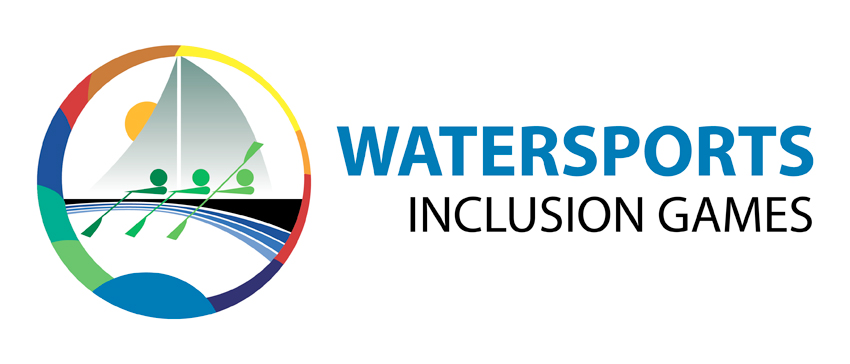
All equipment will be provided, and no experience is required for the free weekend that will include sailing, rowing, canoeing and fast boat rides, with more watersports likely to be added.
Clubs, organisations and community groups working with people with disabilities who are interested in bringing a group or individuals, or in having a presence at the expo element of the event, are invited to register their interest.
Individuals interested in attending the event with up to two family members or friends may also register, as can watersports activity providers who would like to showcase their organisation. Volunteers of all experience levels are also needed for the weekend.
Children aged under 18 and vulnerable adults attending must be accompanied by a responsible adult at all times.
For more details visit the Facebook event page. For all registrations of interest, contact Johanne at [email protected] who will outline booking details.
Kinsale’s RNLI lifeboat volunteers have a very special guest joining them in the town’s St. Patrick’s Day parade this Sunday 17 March.
Paddy the horse, rescued by the RNLI crew in dramatic circumstances on Sunday 17 February, will lead the RNLI float in the parade.
Paddy’s hoof became wedged in the trestles of a submerged oyster bed when his owner, Paul Crowley, was washing him down in the Bandon River.
With the tide rising fast, the lifeboat crew was in a race against time.
Not wishing to further spook the distressed animal, the lifeboat remained at a safe distance while RNLI volunteers Jonathan Connor and Michael P Sullivan entered the water and successfully set Paddy free.
When they called to check on Paddy a few days later, they received a generous donation from the Crowley family and took the opportunity to offer Paddy a starring role in Kinsale’s St Patrick’s Day parade.
RNLI volunteer Jonathan Connor said: “We asked Paddy straight up did he want to do it — yay or nay? He didn’t neigh, so we took it as a yes!”
Paul will ride Paddy in the parade alongside his daughter Lauren on her pony Bailey.
Paul believes Paddy would have been lost had the lifeboat not been launched, and says the entire family wants to help promote the lifesaving work of the RNLI.
Kevin Gould, lifeboat operations manager at Kinsale RNLI, said: “We are honoured to have Paddy lead us in the parade and we thank the Crowley family for supporting the RNLI.
“Paddy’s rescue shows how quickly you can get into difficulty, even close to the shore. It reinforces the RNLI’s message to always respect the water.
“We want people to enjoy the water, but we also want you to recognise its dangers and never underestimate its power.”
#Lifeboats - It was a different kind of ‘surf and turf’ when three teenagers and a horse were rescued in two separate callouts by Kinsale's RNLI volunteers yesterday (Sunday 17 February).
Late in the afternoon the lifeboat launched following reports that a swimmer had sustained a knee injury after entering the water near cliffs off Sancycove Island, a popular site with open-water swimmers.
When the lifeboat arrived on the scene, the crew lifted the casualty and two other swimmers into the lifeboat where they were assessed.
They were brought back to the station where a further medical assessment was conducted by trained RNLI personnel and nurse Emer Scannell, who was at the station visiting a crew member.
The casualty was later taken by ambulance to hospital.
Earlier in the day, the Kinsale lifeboat crew races to the rescue of a horse named Paddy that got into difficulties in the Bandon River.
The horse’s hoof was trapped in the framework of an oyster bed, requiring a member of the volunteer crew to dive under the water and release the panicked animal.
After several attempts, Paddy was safely returned to the shore, much to the relief of his owners.
Kevin Gould, lifeboat operations manager at Kinsale RNLI, said: “We urge everyone to exercise extreme caution on or near the water, particularly at this time of year.
“On days like today our RNLI training proves invaluable and we are all relieved that both call-outs ended well.
“Today’s rescues give a new meaning to the expression ‘surf and turf’.”
Kinsale Yacht Club Objects To Mussel Farming Licence
Kinsale Yacht Club is encouraging its members to make submissions on the recent licence application for a mussel farm off Castlepark Beach in the West Cork harbour.
Following its previous trial in the area, Woodstown Bay Shellfish — based in Dunmore East, Co Waterford — made its application late last year for an Aquaculture Licence to dredge for mussels at a site of around 25 hectares beyond James Fort.
The application also states that the site is located in or adjacent to a sensitive area, the closest to the site being the Sovereign Islands Special Protection Area.
A public notice was published in the Southern Star last Thursday 7 February, and submissions must be made prior to Wednesday 6 March quoting the reference T05/472A to:
Department of Agriculture Food and the Marine
Aquaculture and Foreshore Management Division
National Seafood Centre
Clonakilty, Co Cork
All submissions must be signed and no fee is required.
Kinsale Yacht Club Commodore David O’Sullivan confirmed that the club has already made its own submission on behalf of KYC members, which is available on the club’s website.
The letter cites the strong tidal current in the proposed location of the mussel bed as a concern – and suggests a recent "notable increase" in mussel growth in the marina, allegedly resulting from mussels from the trial being washed towards the town after stormy conditions.
“We must do all we can to preserve our beautiful harbour and every little helps,” Cdre O’Sullivan said.
Great Start for Kinsale Yacht Club Frostbites
The Custom Rigging Frostbites at Kinsale Yacht Club got off to a great start on a beautiful sunny Sunday with a medium SW breeze rather than the forecasted gale.
Race Officer John Stallard assisted by Sue Horgan aboard the lovely Destiny (Bruce & June Matthews) got the three fleets off to a prompt start 1100 HRS immediately followed by two further races with everybody ashore at 1430 HRS in time for a hot soup in the club.
Three fleets raced (Squibs, Topper and Lasers) with 20 boats in all.
The racing was very tight with no quarter given and the points spread is very close going into day two.
Squibs
The nine boat Squib fleet was led by Allegro (Colm Dunne & Rob Gill) who got three firsts on the day with Outlaw (Ian Travers & Keith O’Riordan) close behind with three seconds and Badger (J Condell & J Cochrane) lying third overall with two third’s in race one and two followed by a fifth in race three.
Lasers
In the four boat Laser Fleet, Dorothy Matthews dominated with three firsts followed by Robert McGarvey with two seconds and a third. Rory Carroll came third on the day, just a nose ahead of Gary Horgan as they both scored 11 points each.
Toppers
The Seven Toppers were led by Frances Corkery with two firsts and a third closely followed by Francesca Lewis who showed consistency by scoring three seconds and Hanna Ackerlind came third overall having scored a first and two thirds.
It will all start again next Sunday 10th at 1100 HRS.
Solitaire Du Figaro Returns To Ireland This Summer In 50th Gala Edition
Following last year’s performance of ‘Flying Irishman’ Tom Dolan and pioneering woman Joan Mulloy in their Solitaire du Figaro debuts, now the renowned solo offshore race is coming to Ireland.
The Solitaire URGO Le Figaro is set to return to Kinsale this summer for the first time since 2009 for its 50th gala edition, with a course that takes in a rounding of Fastnet Rock to Kinsale on the weekend of 8-9 June to end its first leg out of Nantes.
The racing fleet continues on a “marathon run” around the Irish coast through the Irish Sea, around the Isle of Man and back down the west coast of Great Britain to Roscoff in northern France.
Stage three is a loop of ‘La Manche’ back to Roscoff before the final stage, via Wolf Rock and the Isle of Wight, to Dieppe. In all the course covers 2,130 miles (not accounting for weather-related changes).
Tom Dolan has already pledged his return for his second Figaro, this time in his new Figaro 3 boat, while the presence of Joan Mulloy — Ireland’s first female entry in the race — will further buoy Irish interest in the challenge as it takes in our coast.
Dolan tells Afloat.ie that he is “itching to get going after three months of computers and meetings!”
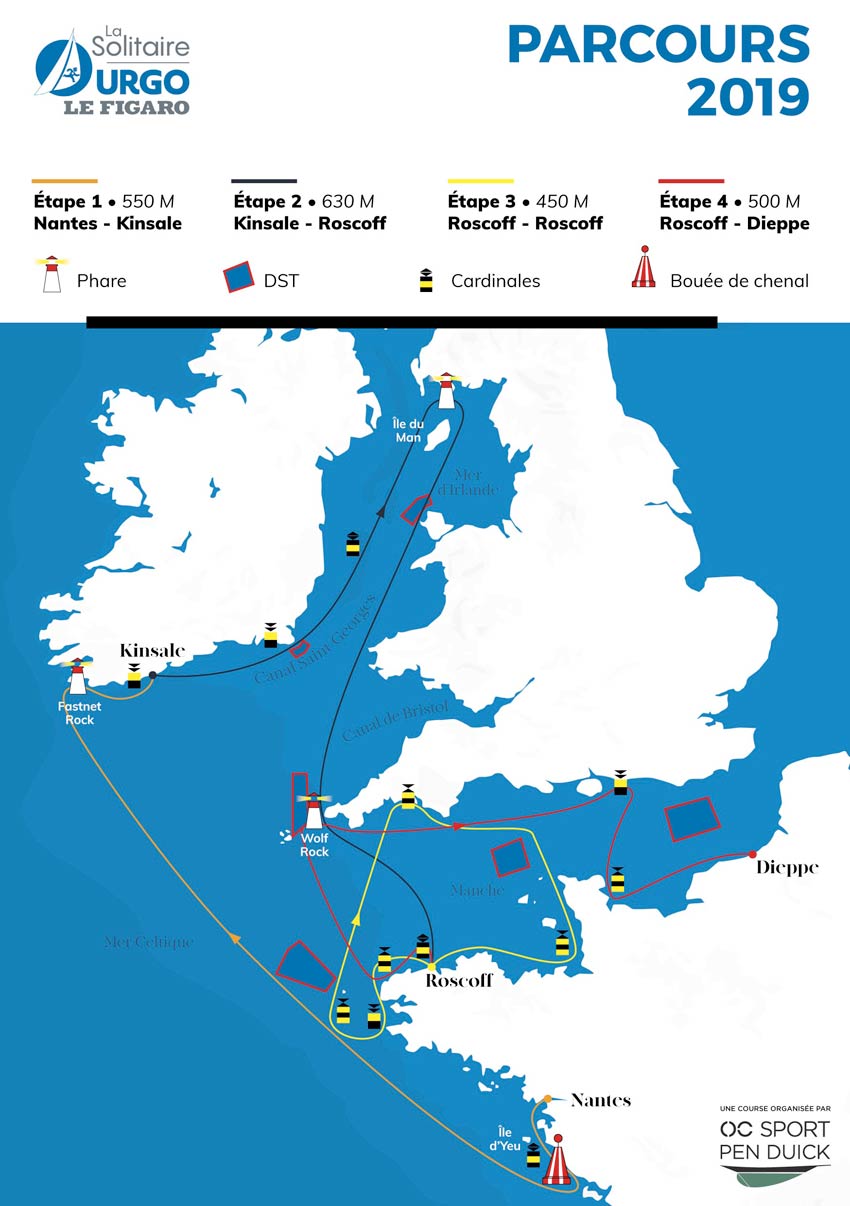
Race organisers add:
The Solitaire URGO Le Figaro is set to enter a new era this year, with the introduction of the new Figaro Bénéteau 3 for the 50th edition of the annual solo sailing race. Starting from the French city of Nantes on June 2nd, 2,130 nautical miles of challenging offshore racing around some of Europe’s roughest waters await the Figaro skippers, including a return to Ireland with a stopover in Kinsale.
Owned and organised by OC Sport’s French subsidiary OC Sport Penduick, the Solitaire URGO Le Figaro is one of the world’s toughest sailing competitions. Fiercely competitive, the race is recognised as the unofficial world championship of solo offshore racing, with the course taking just over a month to complete. Requiring a unique skill set, the Solitaire URGO Le Figaro pushes competitors to the edges of their physical and mental limits.
OC Sport Pen Duick Event Director Mathieu Sarrot commented: “This anniversary year of the Solitaire is set to be an historic edition and we are expecting a diverse fleet including previous winners and new comers to the new Figaro Bénéteau 3. This means the stakes will be high with everyone out to prove themselves in a new boat.
“On the water it will be particularly challenging,” Sarrot continued. “To be successful the competitors will need seasoned offshore experience as well as coastal knowledge. But also sheer grit and determination. With the ongoing support of our title partner URGO, it’s set to be an incredible 50th edition."
The fleet will start leg 1 under the striking bridge of Saint-Nazaire following a passage through the river Loire from the historic city of Nantes in Brittany. After rounding Île d’ Yeu, they will head across the Celtic Sea before passing the legendary Fastnet Rock and heading to the port of Kinsale, Ireland. At 500 nautical miles, the fleet will be immersed in a tough race from the off with a drag race through potentially choppy seas to keep the solo skippers on their toes before they arrive in Irish waters.
Speaking on behalf of the Kinsale Chamber of Tourism and Business, Board Member Ciaran Fitzgerald and Chairperson Guny Patel commented: “Kinsale Chamber is delighted with the announcement that the 50th Anniversary of the prestigious La Solitaire Le Figaro yacht race has been awarded to Kinsale for June 2019.
“This is an amazing event for Kinsale to host and welcome back having hosted this world famous single handed race more than any Port over the 50 years of the race. Kinsale Chamber looks forward to welcoming the sailors and visitors for what will be an incredible spectacle on sea and land over the five days of the stopover. Congratulation to Enda O'Coineen and his team for bringing this event to Ireland.”
Expected to arrive in Kinsale on Wednesday 5th June, the Solitaire URGO Le Figaro fleet will stay in Ireland until Sunday 9th June, when the skippers will set sail on the longest 630-nautical mile Leg 2 to Roscoff in northern Brittany. In a first for the Figaro fleet, this marathon stage will take the skippers along the stunning Irish coast and through the unpredictable, and at times dangerous, Irish sea before rounding the Isle of Man. A long descent along the rugged western Welsh coast, followed by a passage between Land's End and the Scilly Isles, before a crossing of the English Channel towards Roscoff will conclude what is sure to be a gruelling leg.
From Roscoff, the fleet will stay in the familiar waters of Brittany where they will tackle a 450 nautical mile coastal course that will require them to use all of their technical and tactical prowess in the strong tidal currents, before returning to Roscoff on Wednesday 19th June.
To end the 2019 Solitaire URGO Le Figaro, the increasingly exhausted fleet have a double Channel crossing to contend with. At 500 nautical miles, the final leg will see the competitors leave Roscoff on Saturday 22nd June to head across the channel towards Land’s End via a starboard rounding of the south cardinal navigation mark off Portsall. From there, they will have to negotiate the difficult conditions along the south coast of England before skirting the Isle of Wight, and crossing back into French waters through one of the world’s busiest shipping lanes. With fast depleting energy, the skippers will need to keep their wits about them as they head to a mark off Barfleur, before the final sprint into the Normandy fishing port of Dieppe.
The skippers are expected to arrive in Dieppe on Wednesday 26th June, with a non-points scoring postlogue race planned for Saturday 29th June allowing the public to see the new Figaro Bénéteau 3’s in action before the official prize giving where the winner of the 2019 Solitaire URGO Le Figaro will be crowned.
As many as 40 Figaro skippers are expected to compete in this 50th anniversary edition, including former winners alongside a plethora of young talent. At 2,130 nm, the 2019 Solitaire URGO Le Figaro course is one of the longest in race history and it will take everything in the skippers’ solo offshore arsenal to get them to the finish line.
With just over five months to go until the build-up begins in Nantes, the skippers will be using this valuable time to take delivery and train on their new Figaro Bénéteau 3’s. A full skippers line-up will be revealed in April.
La Solitaire URGO Le Figaro 2019 Schedule
May 27th: Arrival of the fleet in Nantes, France
June 2nd, Leg 1 start: Nantes, France – Kinsale, Ireland (via Fastnet Rock) – 500nm
June 9th, Leg 2 start: Kinsale, Ireland – Roscoff, France (via the Isle of Man) – 360nm
June 16th, Leg 3 start: Roscoff, France – Roscoff, France - 450nm
June 22nd, Leg 4 start: Roscoff, France – Dieppe, France – 460nm
June 26th: Anticipated arrival of first boats in Dieppe
June 29th: Postlogue and awards ceremony in Dieppe


























